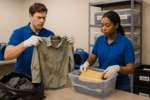How Adjusters Can Salvage Textiles at First Inspection

Professional textile assessment during initial claim inspections requires systematic evaluation techniques that distinguish between salvageable items and those requiring replacement. Understanding damage patterns, restoration possibilities, and assessment protocols enables adjusters to make informed decisions that optimize claim outcomes while supporting accurate scoping and documentation.
Salvage textile evaluation during first inspections prevents missed restoration opportunities while ensuring appropriate resource allocation and realistic timeline planning for comprehensive claim resolution.
Understanding Textile Damage Assessment Principles
Fundamental Damage Classification Systems
Textile damage assessment requires understanding how different damage types affect fabric restoration possibilities and treatment requirements. Systematic damage classification enables consistent evaluation decisions while supporting accurate claim documentation and restoration planning.
Surface contamination typically presents different restoration challenges than structural damage, with surface issues often addressable through professional cleaning, while structural damage may require replacement consideration. Understanding these distinctions guides appropriate assessment decisions.
Progressive damage patterns help adjusters understand how damage develops over time and which items require immediate attention to preserve restoration opportunities. Time-sensitive assessment decisions can significantly impact overall claim outcomes and costs.
Material-Specific Assessment Considerations
Different textile materials exhibit varying responses to damage and restoration treatments, requiring material-specific assessment approaches that consider fabric types, construction methods, and treatment possibilities. Professional assessment accounts for these material variations.
Natural fiber textiles often respond differently to damage and restoration than synthetic materials, with corresponding differences in restoration feasibility and treatment approaches. Understanding material characteristics supports accurate assessment decisions.
Natural fibres, like wool, tend to be more porous and absorb damaging particles more readily. This can make them stubborn materials to restore without further damaging the fibres.
Specialty textiles, including delicate fabrics, designer items, and custom textiles, may require specialized assessment expertise that extends beyond standard evaluation protocols. Recognizing specialty items ensures appropriate treatment considerations.
Systematic Inspection Protocols for Textile Assessment
Comprehensive Visual Assessment Techniques
Professional visual inspection techniques enable rapid evaluation of textile condition while identifying restoration opportunities and potential challenges. Systematic visual assessment provides a foundation for accurate restoration planning and claim documentation.
Damage pattern recognition helps adjusters understand contamination sources and distribution while evaluating restoration feasibility across different textile categories. Pattern analysis supports efficient assessment and resource planning.
Condition documentation standards ensure comprehensive recording of textile status while supporting restoration planning and claim processing requirements. Professional documentation prevents oversight and supports decision accountability.
Environmental Factor Evaluation
Moisture assessment provides critical information about restoration timing and feasibility while identifying items requiring immediate attention to prevent further damage progression. Moisture evaluation guides priority decisions and treatment planning.
Contamination level evaluation helps determine appropriate handling protocols and treatment requirements while ensuring safety and restoration effectiveness. Professional contamination assessment protects both restoration success and worker safety.
Air quality considerations during textile assessment protect adjuster health while providing insights into damage severity and treatment requirements. Environmental awareness supports safe and effective assessment practices.
Restoration Opportunity Identification
High-Probability Restoration Categories
Certain textile categories, like linen or leather, typically present favorable restoration opportunities when damage assessment indicates appropriate treatment feasibility. Understanding these categories helps adjusters identify likely restoration successes while planning claim resources effectively.
Professional assessment of common restoration opportunities includes evaluation techniques that recognize favorable damage patterns and material conditions that support successful restoration outcomes. Systematic opportunity identification optimizes claim results.
Cost-effectiveness evaluation compares restoration possibilities with replacement costs while considering time factors and customer preferences. Economic analysis supports optimal claim resolution decisions.
Specialty Assessment Requirements
High-value salvage textiles require specialized assessment expertise that considers both material value and restoration complexity while ensuring appropriate treatment recommendations. Specialty item evaluation may require expert consultation for optimal outcomes.
Sentimental item considerations involve understanding emotional value factors while providing a realistic assessment of restoration possibilities. Sensitive communication about restoration feasibility supports customer satisfaction and claim acceptance.
Custom and designer textile assessment requires an understanding of specialized materials and construction methods that affect restoration approaches and success probabilities. Expert evaluation ensures appropriate treatment decisions for valuable items.
Professional Communication and Expectation Management
Customer Communication Strategies
Professional communication about textile restoration possibilities requires balancing optimism with realistic expectations while providing clear information about assessment results and treatment options. Effective communication supports customer understanding and cooperation.
Educational approaches help customers understand restoration processes and possibilities while managing expectations about outcomes and timelines. Customer education supports informed decision-making and satisfaction with claim outcomes.
Transparency in assessment results builds trust while providing clear information about restoration possibilities and limitations. Honest communication prevents disappointment while supporting appropriate restoration decisions.
Documentation and Reporting Standards
Comprehensive documentation of textile assessment results provides a foundation for restoration planning while supporting claim processing and audit requirements. Professional documentation ensures accountability and decision support.
Assessment reasoning documentation explains evaluation decisions while justifying restoration recommendations or replacement determinations. Clear reasoning supports claim integrity and decision accountability.
Photographic documentation standards capture textile condition and damage patterns while providing visual evidence that supports assessment decisions and restoration planning. Visual documentation enhances claim accuracy and processing efficiency.
Advanced Assessment Techniques and Considerations
Technology-Enhanced Evaluation Methods
Digital documentation tools provide enhanced assessment capabilities while improving organization and accessibility of evaluation results. Technology integration supports more comprehensive and efficient assessment processes.
Moisture detection equipment enables accurate assessment of water damage and drying requirements while supporting appropriate treatment timing and restoration feasibility determinations. Technical assessment tools enhance evaluation accuracy.
Air quality monitoring during assessment protects adjuster health while providing insights into contamination levels and safety requirements for restoration processing. Professional monitoring supports safe and effective assessment practices.
Collaborative Assessment Approaches
Specialist consultation for complex salvage textile assessment ensures appropriate expertise application while optimizing restoration outcomes for challenging items. Professional collaboration enhances assessment accuracy and restoration success.
Team assessment approaches involving multiple professionals provide a comprehensive evaluation while ensuring that all relevant factors receive appropriate consideration. Collaborative evaluation supports optimal claim outcomes.
Continuing education in textile assessment techniques ensures current knowledge of restoration capabilities and industry best practices. Professional development enhances assessment accuracy and claim optimization.
Risk Management and Quality Assurance
Assessment Accuracy and Consistency
Systematic assessment protocols ensure consistent evaluation standards while supporting accurate restoration planning and claim documentation. Standardized approaches prevent oversight and support professional accountability.
Quality control procedures for assessment documentation maintain high standards while ensuring comprehensive coverage of all relevant evaluation factors. Quality assurance supports claim integrity and processing efficiency.
Regular assessment training and updates ensure current knowledge of restoration capabilities and industry standards while maintaining professional competence in textile evaluation. Ongoing education supports assessment accuracy and effectiveness.
Legal and Compliance Considerations
Professional assessment standards ensure compliance with industry requirements while protecting against liability issues related to evaluation decisions. Compliance awareness supports professional accountability and claim integrity.
Documentation requirements for assessment decisions provide legal protection while supporting claim processing and audit requirements. Comprehensive documentation protects professional interests and claim validity.
Ethical considerations in textile assessment ensure fair and honest evaluation while supporting customer interests and claim integrity. Ethical practices support long-term professional success and industry reputation.
The most effective textile assessment approach combines systematic evaluation techniques with comprehensive documentation:
- Visual inspection protocols that identify damage patterns and restoration opportunities
- Material-specific evaluation techniques that account for fabric characteristics and treatment possibilities
- Environmental assessment that considers contamination levels and safety requirements
- Documentation standards that support restoration planning and claim processing
- Communication strategies that manage customer expectations while providing clear information
Ready to enhance your textile assessment skills and claim optimization capabilities? Visit our blog for comprehensive evaluation techniques and professional development resources, or contact us directly to discuss how expert textile consultation can support your assessment accuracy and claim outcomes.
Related Blogs
How to Build Effective Referral Partnerships in Restoration


How to Effectively Communicate Textile Restoration Timelines to Policyholders


